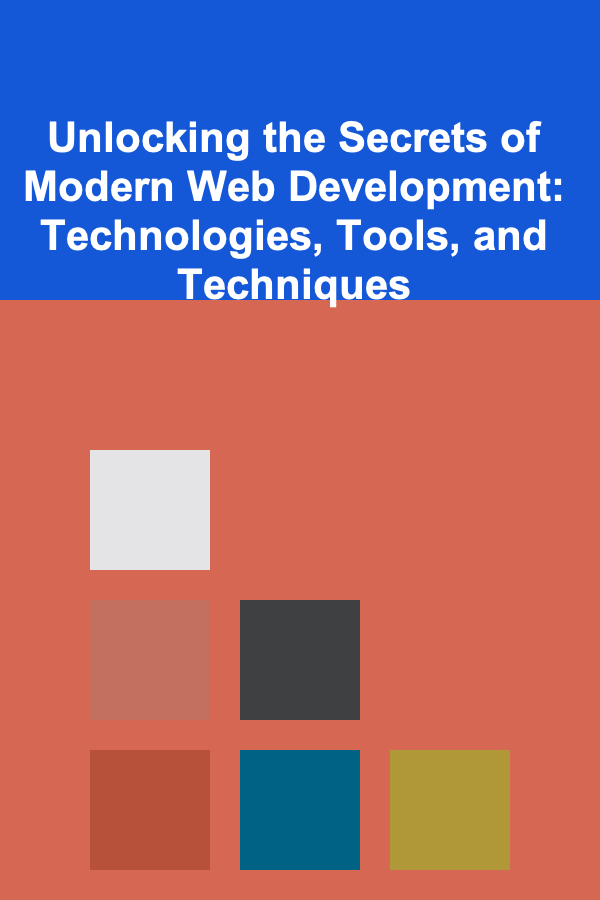
Unlocking the Secrets of Modern Web Development: Technologies, Tools, and Techniques
ebook include PDF & Audio bundle (Micro Guide)
$12.99$5.99
Limited Time Offer! Order within the next:

Web development has come a long way since the early days of the internet. What started with basic static web pages has evolved into highly dynamic, feature-rich applications that power everything from e-commerce stores to social media platforms and real-time collaboration tools. Modern web development involves a combination of cutting-edge technologies, sophisticated tools, and techniques that allow developers to create highly interactive, performant, and scalable web applications.
In this actionable guide, we'll unlock the secrets of modern web development by exploring key technologies, tools, and techniques that you need to master in order to stay competitive in the field.
The Core Technologies Behind Modern Web Development
To understand modern web development, it's crucial to start with the core technologies that lay the foundation for the web. These are the building blocks that all web developers should be familiar with.
HTML5: The Structural Backbone
HTML (Hypertext Markup Language) is the backbone of web development. HTML5, the latest version, brings a host of new features, such as native support for audio, video, and local storage, making it a powerful tool for building interactive and multimedia-rich web pages.
Key Features of HTML5:
- Semantic elements : HTML5 introduces semantic tags like
<header>,<footer>,<article>, and<section>to help structure content more meaningfully. This improves accessibility and search engine optimization (SEO). - Multimedia support : The
<audio>and<video>tags enable embedding audio and video without third-party plugins. - Local storage : The
localStorageandsessionStorageAPIs allow storing data on the client side, making it possible to build offline-capable web applications.
CSS3: Styling and Layouts
CSS (Cascading Style Sheets) controls the layout and visual design of a web page. CSS3, the latest evolution of CSS, introduces advanced styling techniques and layout capabilities.
Key Features of CSS3:
- Flexbox and Grid: These modern layout systems allow for responsive, fluid layouts without the need for float-based or complex positioning techniques.
- Animations and Transitions: CSS3 provides native support for animations and transitions, making it possible to animate elements with minimal JavaScript, improving performance and user experience.
- Media Queries: With the rise of mobile-first design, media queries enable responsive design by applying different styles depending on the device's screen size.
JavaScript: The Interactivity Engine
JavaScript is the programming language that adds interactivity to web pages. Whether it's form validation, asynchronous data fetching, or updating the DOM (Document Object Model) dynamically, JavaScript powers the interaction layer of most modern web applications.
Key Features of Modern JavaScript (ES6+):
- Arrow functions : Simplify syntax and maintain the context of
thiswith arrow functions. - Async/Await: Make asynchronous code look and behave like synchronous code, improving readability and maintainability.
- Modules: JavaScript ES6 modules allow developers to organize and reuse code across different files, promoting a modular approach to development.
- Promises: A more manageable way of handling asynchronous operations compared to callbacks, making code cleaner and less prone to errors like callback hell.
The Browser and Its Role
Web browsers are the platforms on which all web applications run. Modern browsers like Google Chrome, Firefox, Safari, and Edge come with advanced developer tools that help developers debug, optimize, and enhance their applications.
- Developer Tools: Tools like Chrome DevTools allow you to inspect elements, monitor network requests, debug JavaScript, and analyze performance. Mastery of these tools is essential for any modern web developer.
- WebAssembly: This technology enables running code written in languages other than JavaScript, such as C or Rust, directly in the browser at near-native speed. It's particularly useful for performance-intensive applications like gaming, simulations, and image/video editing.
Advanced Front-End Frameworks and Libraries
Modern web development is heavily influenced by the use of front-end frameworks and libraries that abstract away much of the complexity of building web applications. These tools speed up development and ensure that applications are scalable and maintainable.
React: The UI Library of Choice
React is a JavaScript library developed by Facebook for building user interfaces. React promotes the creation of reusable UI components, which makes it easy to build large-scale applications.
Key Concepts of React:
- Component-Based Architecture: React promotes building applications as a collection of small, reusable components that can maintain their state and render efficiently.
- Virtual DOM: React uses a virtual DOM to optimize updates. It calculates the difference between the current and previous virtual DOMs, and only applies the necessary changes to the real DOM, improving performance.
- Hooks: Introduced in React 16.8, hooks allow functional components to use state and other lifecycle features, reducing the need for class components.
Vue.js: Progressive JavaScript Framework
Vue.js is a progressive JavaScript framework that is designed to be incrementally adoptable. Vue is similar to React but offers a more opinionated approach, which can be beneficial for teams looking for a more complete solution.
Key Features of Vue.js:
- Two-Way Data Binding: Vue provides two-way data binding, which allows the model and view to stay synchronized automatically.
- Vue Router: Vue comes with an official router for building single-page applications (SPAs) that seamlessly handle navigation between views.
- Vuex: A state management pattern for managing complex states in large applications, similar to Redux in React.
Angular: A Full-Fledged Framework
Angular is a comprehensive framework developed by Google for building dynamic web applications. It offers a complete solution for building single-page applications, from routing to state management to form validation.
Key Features of Angular:
- TypeScript: Angular uses TypeScript, a statically typed superset of JavaScript, which adds type safety, interfaces, and other advanced features to JavaScript.
- Dependency Injection: Angular has a built-in dependency injection system, which makes it easier to manage service instances and decouple components.
- Angular CLI: The Angular CLI (Command Line Interface) simplifies development by providing tools for generating components, services, and modules, as well as managing builds and testing.
Back-End Technologies for Full-Stack Development
While front-end frameworks are essential for creating engaging user experiences, back-end technologies handle data management, authentication, and server-side logic. In modern web development, back-end technologies are often used in conjunction with front-end frameworks to create full-stack applications.
Node.js: JavaScript on the Server
Node.js allows JavaScript to run on the server side, making it possible to use the same language for both front-end and back-end development. This has led to the rise of full-stack JavaScript development.
Key Features of Node.js:
- Non-blocking I/O: Node.js operates on a single-threaded, non-blocking event-driven model, making it well-suited for real-time applications and services that require scalability.
- npm (Node Package Manager): npm is the largest ecosystem of open-source libraries, making it easy to integrate third-party packages and tools into your Node.js application.
- Express.js: A lightweight and flexible web application framework for Node.js that simplifies routing, middleware, and other server-side functionality.
Django: A Python-Based Framework
Django is a high-level Python web framework that allows developers to rapidly build secure and maintainable web applications. It is known for its "batteries-included" philosophy, providing a full set of tools for handling common web development tasks.
Key Features of Django:
- Admin Interface: Django comes with an automatic admin interface that makes managing application data easy without writing additional code.
- ORM (Object-Relational Mapping): Django's ORM abstracts database queries into Python classes, allowing you to interact with databases using Python code instead of SQL.
- Security: Django includes built-in protection against common security threats such as cross-site scripting (XSS), cross-site request forgery (CSRF), and SQL injection.
Ruby on Rails: Convention Over Configuration
Ruby on Rails (Rails) is a popular full-stack web application framework written in Ruby. It emphasizes convention over configuration, making it easy to get started with web development without requiring a lot of boilerplate code.
Key Features of Ruby on Rails:
- ActiveRecord ORM: Rails uses ActiveRecord, an ORM that makes database interactions intuitive and straightforward.
- RESTful Design: Rails encourages developers to use RESTful principles when designing APIs, making it easier to create scalable and maintainable web applications.
- Rich Ecosystem: Rails has a large ecosystem of gems (libraries) that add functionality ranging from authentication to file uploads to payments.
Tools and Techniques for Improving Web Development Workflow
Version Control with Git
Git is an essential tool for modern web developers. It enables version control, allowing you to track changes in your codebase, collaborate with others, and roll back changes if something goes wrong.
Best Practices for Using Git:
- Commit Often: Make frequent commits to capture the incremental changes you make.
- Branching: Use branches to manage new features, bug fixes, or experiments separately from the main codebase.
- Pull Requests: Use pull requests to review and discuss code changes before merging them into the main branch.
Testing and Quality Assurance
Automated testing is a critical part of modern web development. It ensures that your application behaves as expected and helps prevent bugs from creeping into your codebase.
Key Types of Testing:
- Unit Testing: Testing individual functions or methods in isolation to ensure they behave correctly.
- Integration Testing: Ensuring that different parts of your application work together seamlessly.
- End-to-End Testing: Testing the entire application flow, simulating real user interactions.
Continuous Integration and Continuous Deployment (CI/CD)
CI/CD pipelines automate the process of integrating and deploying code changes. With CI/CD tools like Jenkins, CircleCI, or GitHub Actions, you can automate testing, building, and deployment, ensuring that code changes are tested and deployed quickly and reliably.
Docker and Containerization
Docker allows you to create lightweight, portable containers that package your application and its dependencies, ensuring consistency across development, testing, and production environments. Docker is invaluable for creating reproducible development setups and deploying microservices.
Conclusion: The Path to Mastery in Modern Web Development
Modern web development is a dynamic field that requires continuous learning and adaptation to new technologies and techniques. By mastering core technologies like HTML, CSS, and JavaScript, as well as modern front-end frameworks like React and back-end tools like Node.js, you'll be well on your way to building scalable, performant, and maintainable web applications. Additionally, adopting best practices in version control, testing, and deployment will help ensure that your development workflow is efficient and reliable.
The key to success in web development lies in staying curious, continuously improving your skills, and embracing new technologies and methodologies that emerge in the fast-paced world of web development. With the right tools and mindset, you'll be able to unlock the secrets of modern web development and build exceptional web applications.
Reading More From Our Other Websites
- [Home Rental Property 101] How to Rent a House with a Pool: A Comprehensive Guide
- [Personal Care Tips 101] How to Apply Hair Oil for a Healthy and Hydrated Scalp
- [Personal Care Tips 101] How to Apply Concealer Without It Settling into Fine Lines
- [Stamp Making Tip 101] The Ultimate Guide to Choosing the Perfect Stamp Making Supplies
- [Personal Care Tips 101] How to Incorporate a Facial Scrub into Your Daily Skincare Routine
- [Home Renovating 101] How to Utilize Storage Solutions in Your Renovation
- [Personal Financial Planning 101] How to Build Wealth Through Smart Money Management
- [Whitewater Rafting Tip 101] Intermediate Rapids: How to Level Up Your Rafting Skills
- [Organization Tip 101] How to Keep Track of RSVPs and Dietary Preferences
- [Personal Investment 101] How to Maximize Returns with Low-Cost Index Funds

How to Clean and Sanitize High-Touch Surfaces During Flu Season
Read More
How to Make Your Home Feel Larger with Strategic Lighting
Read More
How to Manage Thread Storage to Prevent Tangling
Read More
How to Organize Your Home Office for Seasonal Productivity
Read More
How To Learn Basic Public Relations
Read More
Building a Legacy Through Your Business
Read MoreOther Products

How to Clean and Sanitize High-Touch Surfaces During Flu Season
Read More
How to Make Your Home Feel Larger with Strategic Lighting
Read More
How to Manage Thread Storage to Prevent Tangling
Read More
How to Organize Your Home Office for Seasonal Productivity
Read More
How To Learn Basic Public Relations
Read More